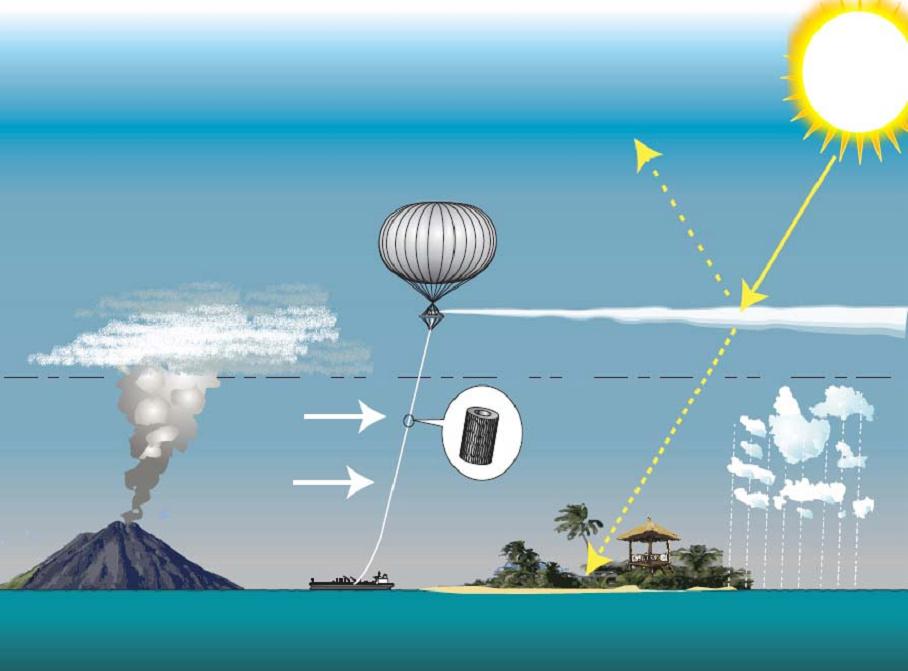Did the IPCC bury the lede regarding solar geoengineering?
Originally posted at Legal Planet.
In my previous posts on the reports of the Intergovernmental Panel on Climate Change (IPCC), I described how models assume the use of uncertain negative emissions technologies at very large — if not impossible — scales in order to keep global warming within 1.5 or two degrees Celsius (1, 2; see also my colleague Julia Stein). Does this mean that we will surpass these limits?
No, not necessarily. For one thing, very aggressive reductions of greenhouse gas emissions coupled with their removal from the atmosphere could keep warming within two degrees. Although I consider it unlikely, I would like to be proven wrong.
There is also a set of proposed technologies that could keep global warming within these or other limits. Through these techniques, we could intentionally alter the earth’s radiative balance, cooling the planet and counteracting anthropogenic climate change. That is, we could make the planet more reflective, block some incoming sunlight, or increase the amount of outgoing infrared radiation.
These suggestions seems outlandish, and they are. But extreme risks may call for extreme responses.
The leading proposed method of such “solar geoengineering” (sometimes called solar radiation management, solar radiation modification, or climate engineering) is inspired by large volcanic eruptions, which naturally cool the planet for a year or so by releasing small particles that linger in the atmosphere and reflect some incoming sunlight. Humans could inject some similar aerosols (that is, a fine mist) into the upper atmosphere. The leading material under consideration is sulfur, because that is what volcanoes release, but others are possible. This stratospheric aerosol injection could be physically accomplished via a number of means, of which modified high altitude aircraft currently appears the most efficient. There are other proposed solar geoengineering techniques, including marine cloud brightening and cirrus cloud thinning.
Why might solar geoengineering succeed while emissions cuts and negative emissions technologies may not? Current evidence from models and volcanoes indicates that it would not only be grossly effective in reducing climate change, but it would also be remarkably inexpensive and fast acting. The former characteristic gives it a distinct problem structure. Emissions cuts are expensive, yet the benefits are spread across the whole world. This presents a collective action problem that requires difficult international cooperation. Solar geoengineering would have such low deployment costs that it might be in countries’ self-interest to undertake it on their own. This presents international coordination problems: Who does it? When? How much? Although coordination can be challenging, it is generally easier than cooperation.
The latter characteristics — speed — is also important. Due to momentum in the earth’s energy balance (primarily from the ocean’s absorption of heat), there is a substantial time lag between changes in greenhouse gas concentrations and in climate. Emissions and their reduction now will influence the climate in a few decades hence. This further weakens politicians’ incentives to adopt policies that are costly in the short run (that is, within re-election cycles) but would pay off in the long run. In contrast, solar geoengineering would be effective within a few months. In this way, the ability to implement it knowledgeably and responsibly could be a sort of insurance against the risks of future dangerous climate change. Hopefully we won’t need to use it, but it seems wise to research and perhaps develop the capacity to do so. Importantly, because solar geoengineering could operate as insurance only when greenhouse gas emissions are also reduced, solar geoengineering is no reason to end efforts to cut them.
Solar geoengineering also presents a number of its own risks, both physical and social. For example, the net impact of elevated carbon dioxide concentrations, reduced heat stress, and diffuse light on agriculture is uncertain. Legitimate decision-making while avoiding international conflicts regarding its use appears challenging. Once begun, we would need to either maintain or end it slowly; doing so suddenly would cause sudden climate change. And would considering and research solar geoengineering undermine our already insufficient efforts to cut greenhouse gas emissions?
So what did the recent IPCC report on 1.5 degrees warming say about solar geoengineering? When its leadership agreed to produce this special report, it decided not to include solar geoengineering in any of its centrally-considered scenarios. Nevertheless, the report does conclude “with high agreement that it could limit warming to below 1.5°C,” (p. 4-56) but that “Uncertainties surrounding Solar Radiation Modification (SRM) measures constrain their potential deployment. These uncertainties include: technological immaturity; limited physical understanding about their effectiveness to limit global warming; and a weak capacity to govern, legitimise, and scale such measures” (p. 4-7). Notably, the former statement regarding physical effectiveness was buried in a box deep in the fourth chapter, while the latter was in both the chapter’s executive summary and paraphrased in the report’s important Summary for Policymakers.
On one hand, this seems like the report buried the lede. After all, the IPCC primarily assesses the causes, consequences, and possible responses to climate change. If solar geoengineering could reduce climate change, policymakers and other readers should know. Furthermore, the IPCC is reluctant to pronounce on the capacity to govern and legitimize aggressive mitigation, but quick to do so in the case of solar geoengineering. On the other hand, I understand the IPCC’s reluctance and solar geoengineering’s controversy. Climate scientists have been saying for decades that we must reduce greenhouse gas emissions, yet now there might be another option. And solar geoengineering seems contrary to everything that the environmental has taught regarding reducing humans’ impact on the Earth.
Solar geoengineering and negative emissions technologies present genuine challenges. Law can and will help us navigate through them. In the next post in this series, I will introduce some of the legal aspects of these technological responses to climate change. (NB: Now posted: “Negative Greenhouse Gas Emissions, the National Academies, and the Law” and “Solar Geoengineering and International Law“)

